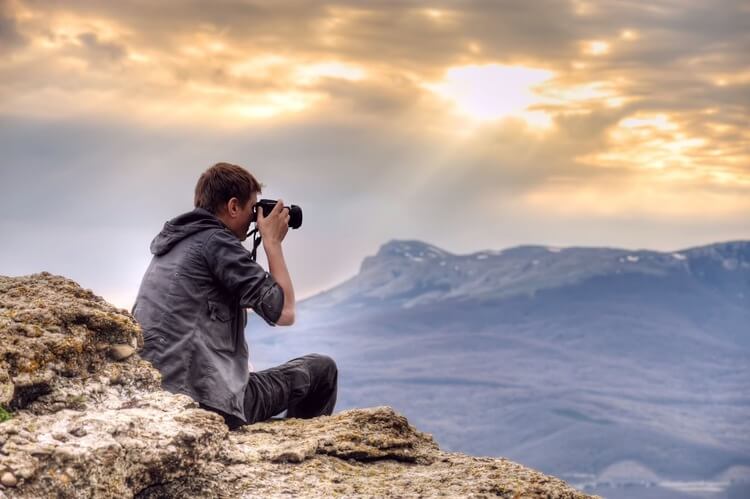TOP 20 best cameras for novice photographers and professionals: 2024-2025 rating and which one is better to buy for high-quality pictures
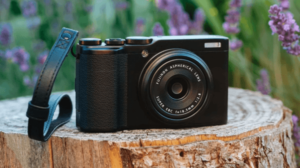 A camera is a special device for fixing objects on a film or digital frame.
A camera is a special device for fixing objects on a film or digital frame.
Despite the fact that all modern smartphones are equipped with cameras, and quite good ones, they do not always lack performance, memory or simple ergonomics.
A good camera is an extension of the eyes and hands of the photographer. How to choose in all the variety presented on the modern market?
Rating of TOP-20 best cameras of 2024-2025
| Place | Name | Price |
|---|---|---|
| TOP 4 best cameras for high-quality pictures | ||
| 1 | Nikon D3500 Kit | Ask for a price |
| 2 | Nikon Z50 Kit | Ask for a price |
| 3 | Canon EOS M50 Kit | Ask for a price |
| 4 | Sony Alpha ILCE-6000 Kit | Ask for a price |
| TOP 4 best SLR cameras for beginner photographers | ||
| 1 | Canon EOS 4000D Kit | Ask for a price |
| 2 | Nikon D5600 Kit | Ask for a price |
| 3 | Canon EOS 2000D Kit | Ask for a price |
| 4 | Canon EOS 250D Kit | Ask for a price |
| TOP 3 best SLR professional cameras | ||
| 1 | Canon EOS 5D Mark IV Body | Ask for a price |
| 2 | Nikon D750 Body | Ask for a price |
| 3 | Canon EOS 6D Mark II Body | Ask for a price |
| TOP 3 best interchangeable lens mirrorless cameras for beginner photographers | ||
| 1 | Panasonic Lumix DMC-G7 Kit | Ask for a price |
| 2 | Olympus Pen E-PL8 Kit | Ask for a price |
| 3 | Canon EOS M100 Kit | Ask for a price |
| TOP 3 best mirrorless professional cameras | ||
| 1 | Sony Alpha ILCE-6400 Kit | Ask for a price |
| 2 | Sony Alpha ILCE-7M3 Body | Ask for a price |
| 3 | Sony Alpha ILCE-7M3 Kit | Ask for a price |
| TOP 3 best digital (compact) cameras | ||
| 1 | Sony Cyber-shot DSC-RX100 | Ask for a price |
| 2 | Canon PowerShot G9 X Mark II | Ask for a price |
| 3 | Fujifilm XF10 | Ask for a price |
Content
- Rating of TOP-20 best cameras of 2024-2025
- How to choose a good camera?
- Types of cameras
- Which is better, a DSLR or a mirrorless camera?
- What to choose - SLR camera or digital?
- What is the difference between cameras for beginners and for professionals?
- The best cameras for quality pictures
- The best DSLRs for beginner photographers
- The best SLR professional cameras
- The Best Interchangeable Lens Mirrorless Cameras for Beginning Photographers
- The best mirrorless professional cameras
- The best digital (compact) cameras
- Customer Reviews
- Useful video
How to choose a good camera?
The camera has many different parameters, for beginner photographers, the main indicators should be considered:
- Matrix. The size of the sensor affects the sensitivity and dynamic range, which reduce digital noise in the picture;
- Permission. Measured in megapixels and displayed on the final photo. A large value of Mn increases the amount of noise;
- Zoom ratio. Describes the camera's ability to capture distant objects. Two types are determined - digital and optical, the first spoils the quality when approaching, the second changes the location of the lenses and does not degrade the image.
Important characteristics for the operation of the device:
- Screen;
- shooting modes;
- Battery Type;
- Connectors (branded or standard);
- Removable memory storage.
For professional shooting, the following indicators are considered:
- Optics. Determines the quality of the photo, the main characteristic is the focal length, measured in mm;
- crop factor. Affects the angle of view using optics with a smaller frame window;
- RAW format. Provides higher detail and eliminates quality errors;
- Megapixels. The number depends on the size of the matrix, the number of dots shows the size of the image that can be printed without losing quality;
- Light sensitivity. A high setting cleans up noise and gives a natural image.
Types of cameras
There are three types of digital cameras:
- compact. It is characterized by small dimensions and weight, lack of a viewfinder, fixed lens. Automatic settings are provided, high-quality shooting only in daylight, battery capacity allows you to take up to 200 shots;
- Mirror. The device for professional use is used for shooting both moving and static objects. Features - large size due to functionality, interchangeable lens, modes, high-resolution matrix, reflex optical viewfinder. The key principle is that the mirror rises before starting work, and the light falls exactly on the matrix. It has a large number of manual settings and has a high price;
- Mirrorless. There is no movable mirror and pentaprism, which reduces the size, the control is simplified, but it has internal advanced functions. The viewfinder is electronic, does not spoil the quality due to the matrix, the optics are interchangeable. Uses fast battery drain due to continuous operation of the sensor and viewfinder.
Which is better, a DSLR or a mirrorless camera?
SLR cameras are much larger, heavier and more demanding to care for..
Mirrorless cameras are smaller, easier to operate, easier to learn. At the same time, mirrorless cameras benefit significantly in terms of video shooting.
The general indicators of a SLR and mirrorless camera that do not affect the quality of shooting are a matrix and interchangeable lenses.
Advantages of a mirrorless device - size, electronic viewfinder, choice of manufacturers.
The reflex camera has a larger fleet of lenses, a long operating time, an optical viewfinder, phase detection autofocus, on-time and ergonomics.
What to choose - SLR camera or digital?
The decision to purchase a digital or SLR camera depends on factors:
- Photo quality;
- Equipment dimensions;
- Subject of shooting;
- Image size;
- Automatic or custom use.
The SLR camera is distinguished by its capabilities and shooting modes, the presence of a viewfinder, high image detail, quality and clarity of photographs, which is characterized by the features of the optics and matrix.
The digital device has compact dimensions, functionality (in more expensive devices), protective properties and additional features.
SLR cameras have recently ceased to be perceived as purely professional and inaccessible to ordinary people and beginners..
And yet, for staging professional shots, mirror models should be preferred.
What is the difference between cameras for beginners and for professionals?
The main difference is the speed of action and the accuracy of automation, the number of controls and advanced settings, the ability to use the camera in harsh conditions.
For the professional photographer, manual adjustments that may not be present in amateur cameras are the impact, so advanced controls differentiate between beginner and expert cameras.
The best cameras for quality pictures
Nikon D3500 Kit
Amateur SLR camera, ideal for beginners and amateurs. 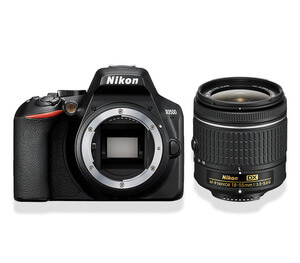
The ergonomics of the model is thought out to the smallest detail: compact size, deep grip, metal bayonet mount.
A device with a reflex viewfinder covers a field of view of 95%, equipped with a 3-inch LCD display.
The matrix supports a maximum number of pixels of 6000 × 4000, automatic light sensitivity of 100-3200 ISO with the ability to adjust - ISO6400, 12800, 100, 25600.
There is exposure bracketing, metering: 3D color, center-weighted, multi-zone, spot.
Exposure time and aperture can be adjusted manually, there is an automatic exposure processing.
Focusing has illumination, electronic rangefinder, focusing on the face and manual adjustment.
Uses SDHC, SD, SDXC memory cards. Video recording is rated at 29 minutes (4 GB) with MOV format.
Functions - white balance adjustment automatically, manually, selectively according to the list. The flash is mounted with red-eye reduction.
It is worth noting that this is one of the best models of 2024-2025.
Technical properties:
- Type - mirror;
- Matrix: type / size / crop factor / MP - CMOS / 23.2 x 15.4 mm / 1.5 / 24.78;
- Timer / shooting rate - 2,5,10,20s / 5fps;
- Shutter opening (X-Sync) - 30-1/4000s (1/200s);
- Autofocus / number of points - phase / 11;
- Frame parameter - JPEG (compressed level 2), RAW;
- Battery - own, for 1550 photos;
- Video resolution, frequency - 50-60 fps at 1280? 720; 50-60 fps at 1920x1080;
- Dimensions / weight - 124x97x70mm / 365 g.
pros
- shooting modes;
- Ergonomics;
- Image quality;
- The weight;
- Focus speed.
Minuses
- No USB charging.
Nikon Z50 Kit
Device with electronic viewfinder and 100% field of view. LCD touch screen 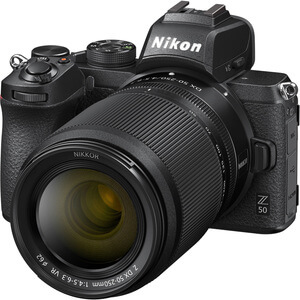
The matrix has a resolution of 6048 × 4024, ISO 50-3200 and advanced modes - ISO51200, 6400, 12800, 50, 102400, 204800, 100, 25600. Built-in exposure bracketing and metering systems.
Possible exposure compensation +/- 5 EV in 1/3 steps, auto-processing, manual adjustment of the hold time and aperture.
Autofocus with backlight and face, can be adjusted manually.
Supports XQD storage, USB charging port, microphone input and headphone output.
The video is recorded in MOV and MP4 format with a duration of 29 minutes. Functions - matrix cleaning; manual, auto and list white balance correction; optical image stability with matrix shift.
i-TTL flash with red-eye reduction. Possibility of computer control or remotely, works in Time-lapse mode, frame size when shooting 3:2, 1:1, 16:9. Interchangeable optics Nikon Z mount.
Technical properties:
- Type - mirrorless;
- Matrix: type/size/crop factor/MP – CMOS/ 35.9×23.9 mm/1/25.28;
- Timer / shooting rate - 2,5,10,20s / 12fps;
- Shutter opening (X-Sync) - 30-1/8000s (1/200s);
- Autofocus / number of points - hybrid / 273;
- Frame parameter - JPEG (compressed level 2), RAW, TIFF;
- Battery - own, for 310 photos;
- Video resolution, frequency -120 fps at 1920?1080; 25-30 fps at 3840?2160;
- Dimensions / weight - 134x101x68mm / 585 g.
pros
- Ergonomics;
- Autonomous work;
- Lens;
- Shooting quality;
- High working ISO.
Minuses
- One XQD type memory card.
Canon EOS M50 Kit
The camera works with an electronic viewfinder, LCD touchscreen rotatable by 3 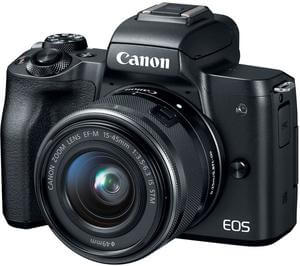
Time-lapse shooting, series of shots up to 33 for JPEG and up to 10 for RAW, picture formats 4:3, 3:2, 1:1, 16:9.
Matrix with 6000 × 4000 pixels, auto sensitivity - 100-3200 ISO with customizable modes ISO6400, 12800, 100, 25600.
Exposure bracketing and auto-processing are provided, center-weighted, total, spot metering, exposure compensation +/- 3 EV in 1/3 steps, manual aperture and exposure time adjustment.
Focusing is carried out on the face, manual selection, autofocus with backlight.
Supports SDHC, SD, SDXC memory cards, video is recorded in MP4 format up to 29 minutes long.
Adjustable white balance, built-in E-TTL II flash, flash up to 5 m, red-eye reduction.
An orientation sensor is mounted, a computer or remote control is possible, a matrix cleaning function and HDR shooting, an interchangeable lens.
Technical properties:
- Type - mirrorless;
- Matrix: type / size / crop factor / MP - CMOS / 22.3x14.9 mm / 1.6 / 25.8;
- Timer / rate of shooting - 2.10s / 10fps;
- Shutter opening - 30 - 1/4000s;
- Autofocus / number of points - contrast / 143 (99 cross);
- Frame parameter - JPEG (Level 2)compressed.), RAW;
- Battery - own, for 235 photos;
- Video resolution, frequency - 120 frames / s at 1280 × 720; 50-60 fps at 1920x1080; 25-30 fps at 3840?2160;
- Dimensions/Weight -116x88x59mm/387g
pros
- Matrix;
- Autofocus;
- Functionality;
- Picture quality;
- Settings.
Minuses
- Lack of accurate display of the remaining battery;
- The lack of information on the screen about the free space on the memory card.
Sony Alpha ILCE-6000 Kit
The device is equipped with an electronic viewfinder, swivel 3 "LCD screen. Matrix with 
Exposure bracketing, metering: multizone, center-weighted, spot. Exposure compensation, auto-processing and manual adjustment of the fixation time and aperture are available.
Autofocus with illumination, manual adjustment and focusing on the face. Support for removable drives - Memory Stick/Duo/PRO-HG Duo/Pro Duo, SDHC, SDXC, SD.
AVCHD and MP4 video recording, HDR shooting, frame sizes - 3:2, 16:9.
Performs sensor cleaning, 3D shooting, flash up to 6 m, white balance adjustment, 4x digital zoom, remote or computer control.
Technical properties:
- Type - mirrorless;
- Matrix: type / size / crop factor / MP - CMOS / 23.5 x 15.6 mm / 1.5 / 24.7;
- Timer / shooting rate - 2.10s / 11fps;
- Shutter opening X-Sync - 1/100s;
- Autofocus - hybrid;
- Frame parameter - JPEG (compressed level 2), RAW;
- Battery - own, for 360 photos, 1080 mAh;
- Video resolution, frequency - 50-60 frames / s at 1920 × 1080;
- Dimensions / weight - 120x67x45 mm / 285 g.
pros
- Image clarity;
- Control;
- High ISOs;
- Manual adjustment;
- Lens.
Minuses
- Number of available optics;
- Frequent cleaning of the matrix.
The best DSLRs for beginner photographers
Canon EOS 4000D Kit
Device with reflex viewfinder, 2.7" LCD. Burst of shots up to 6 frames per 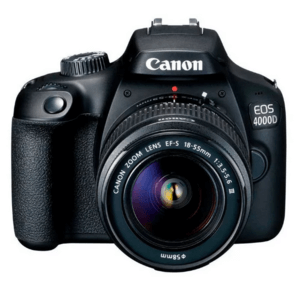
The maximum number of pixels of the matrix is 5184 × 3456, autosensitivity in the range of 100-3200 ISO with a choice of ISO6400, 12800, 100.
There is manual adjustment of exposure time and aperture, auto exposure processing.
Exposure compensation, measurements - estimated, center-weighted, total, spot; bracketing.
Focusing on the face, with backlight and possible manual adjustment. SDHC, SD, SDXC memory cards, RAW+JPEG simultaneous recording.
MOV video up to 29 minutes (4GB).
Computer control or remote control available, white balance adjustment, E-TTL II flash up to 9.2 m with red-eye reduction.
Technical properties:
- Type - mirror;
- Matrix: type / size / crop factor / MP - CMOS / 22.3x14.9 mm / 1.6 / 18.7;
- Timer / shooting rate - 2-10s / 3fps;
- Shutter opening (X-Sync) - 30-1/4000s (1/200s);
- Autofocus - phase;
- Frame parameter - JPEG (compressed level 2), RAW;
- Battery - own, for 500 photos;
- Video resolution, frequency - 50-60 fps at 1280? 720; 25-30 fps at 1920x1080;
- Dimensions / weight - 129x102x77 mm / 436 g.
pros
- Interface;
- Autonomous work;
- Functionality;
- Image quality.
Minuses
- Lack of stabilization;
- Rigid fixation of the display.
Nikon D5600 Kit
The device is equipped with a reflex viewfinder with a field of view of 95%, equipped with an LCD
Compatible with Time-lapse mode and 3:2 frame.The automatic sensitivity of the matrix is 100-3200 ISO with advanced settings ISO6400, 12800, 100, 25600, resolution 6000 × 4000.
Exposure bracketing, auto-processing and metering functions.
Exposure compensation ± 5 EV in 1/3 steps, manual aperture and hold time adjustment.
Autofocus with single shot, AI focus, tracking, face, manual focus modes.
Supports removable storage SDHC, SD, SDXC, Wi-Fi, USB, Bluetooth, HDMI, NFC and microphone input.
MOV video recording, HDR shooting. There is a remote control or from a computer, matrix cleaning, orientation sensor.
Technical properties:
- Type - mirror;
- Matrix: type / size / crop factor / MP - CMOS / 23.5 x 15.6 mm / 1.5 / 24.78;
- Timer / shooting rate - 2,5,10,20s / 5fps;
- Shutter opening X-Sync - 1/100s;
- Autofocus / number of points - phase / 39;
- Frame parameter - JPEG (compressed level 3), RAW;
- Battery - own, for 820 photos;
- Video resolution, frequency - 60 fps at 1280x720; 60 fps at 1920×1080;
- Dimensions / weight - 124x97x70 mm / 420 g.
pros
- Wireless technologies;
- Image clarity and sharpness;
- Control;
- Manual settings.
Minuses
- Quality in low light.
Canon EOS 2000D Kit
Machine with optical viewfinder and visibility coverage of 95% equipped with LCD display. 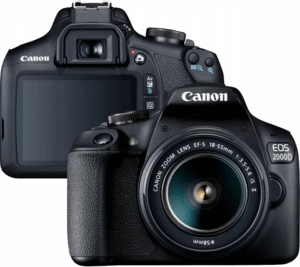
Metering systems - center-weighted, total, spot, there is bracketing and exposure compensation.
Auto-processing with aperture or shutter priority, making manual changes.
Focusing with highlighting, manual mode and face.
SDHC, SD, SDXC card support, RAW+JPEG dual recording, 29 minutes MOV video.
Flash E-TTL II built-in, it is possible to connect an external one, the range of application is up to 9 m.
The white balance is adjusted manually, automatically or according to the list. Interchangeable lenses with Canon EF/EF-S mount.
Technical properties:
- Type - mirror;
- Matrix: type / size / crop factor / MP - CMOS / 22.3 x 14.9 mm / 1.6 / 24.7;
- Timer / shooting rate - 2-10s / 3fps;
- Shutter opening - 30-1 / 4000s;
- Autofocus - phase;
- Frame parameter - JPEG (compressed level 2), RAW;
- Battery - own, for 500 photos;
- Video resolution, frequency - 50-60 fps at 1280? 720; 50-60 fps at 1920x1080;
- Dimensions / weight - 129x101x78 mm / 475 g.
pros
- Built-in settings;
- Wide optical spectrum;
- Ergonomics;
- Matrix.
Minuses
- Weak processor;
- Lack of central contact on the shoe.
Canon EOS 250D Kit
The camera is equipped with a reflex viewfinder and a tilting LCD touch screen with 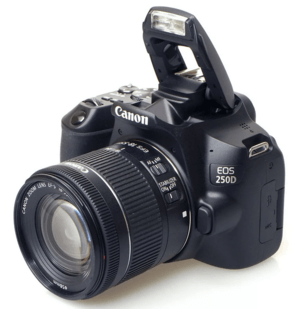
The matrix has a light sensitivity of 100-25600 ISO and extended ISO6400, 12800, there is an automatic cleaning.
Exposure bracketing and exposure compensation are used. Measurements: center-weighted, total, spot; automatic processing and manual adjustment of exposure time and aperture.
SDHC, SDXC, SD memory cards, has a microphone input and a remote control connector. Video recording in MOV, MP4 formats up to 30 minutes, photo format 4:3, 3:2, 1:1, 16:9.
Supports remote control, orientation sensor, white balance correction and optical image stabilization.
Built-in flash with working radius up to 10 m. Interchangeable lens mount Canon EF.
Technical properties:
- Type - mirror;
- Matrix: type / size / crop factor / MP - CMOS / 22.3 x 14.9 mm / 1.6 / 25.8;
- Timer / rate of shooting - 2.10s / 5fps;
- Shutter opening (X-Sync) - 30-1/4000s (1/200s);
- Autofocus / number of points - phase / 9;
- Frame parameter - JPEG, RAW;
- Battery - own, for 1070 photos;
- Video resolution, frequency - 50-60 fps at 1280? 720; 50-60 fps at 1920x1080; 24 fps at 3840×2160;
- Dimensions / weight - 122x93x70 mm / 451 g.
pros
- Image quality;
- Video mode;
- Autonomous work;
- Swivel screen.
Minuses
- Autofocus;
- Factory settings.
The best SLR professional cameras
Canon EOS 5D Mark IV Body
Camera with a reflex viewfinder, equipped with an LCD display and a second screen. In 
The matrix works with auto sensitivity in the range of 100-3200 ISO with additional parameters ISO51200, 6400, 12800, 102400, 100, 25600.
It is possible to auto-process exposure with shutter or aperture priority, manual adjustment of exposure time.
The metering system is divided into center-weighted, evaluative, spot, bracketing and exposure compensation are used.
Autofocus is manually adjusted, with backlight and face focus. Removable storage support SDHC, SD, SDXC, Compact Flash/Type II, RAW+JPEG dual mode. Video recording lasts 29 minutes in two formats MOV and MP4.
There is protection against dust and moisture, matrix cleaning, Live View mode. Supports Canon EF mount interchangeable lens.
Control functions remotely or from a computer, orientation sensor, GPS, white balance adjustment (auto and manual).
E-TTL II flash with red-eye reduction and flash sync. The kit does not include a lens.
Technical properties:
- Type - mirror;
- Matrix: type / size / crop factor / MP - CMOS / 36 × 24 mm / 1 / 31.7;
- Timer / shooting rate - 2.10s / 7fps;
- Shutter opening X-Sync - 1/100s;
- Autofocus / number of points - phase / 61 (41 cross);
- Frame parameter - JPEG (compressed level 3), RAW;
- Battery - own, for 900 photos;
- Video resolution, frequency - 120 frames / s at 1280 × 720; 50-60 fps at 1920x1080; 25-30 fps at 4096?2160;
- Dimensions / weight - 151x116x76 mm / 800 g.
pros
- ISO range;
- Touch screen;
- Remote control;
- Transferring files to another device;
- Autofocus.
Minuses
- Battery life.
Nikon D750 Body
A device with a mirror viewfinder, LCD display 3.2? with additional 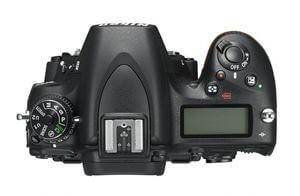
The maximum number of pixels of the matrix is 6016 × 4016, ISO 50-3200 with a choice of ISO51200, 6400, 12800, 100, 25600.
The exposure has matrix, center-weighted and spot metering, automatic processing with shutter or aperture priority.
It is possible to manually adjust the fixation time or aperture, bracketing, exposure compensation.
When focusing, an electronic rangefinder is used, a backlight can be adjusted manually and by the face.
Compatible memory cards: SDHC, SD, SDXC; MOV video recording up to 30 minutes.
Adjustable white balance, there is an orientation sensor, the possibility of computer control or remotely.
Built-in flash with a range of up to 12 m, red-eye reduction. Additionally, there is an HDMI type C connector and Active D-Lighting bracketing.
This model is highly reliable for 2024-2025.
Technical properties:
- Type - mirror;
- Matrix: type / size / crop factor / MP - CMOS / 35.9 x 24 mm / 1 / 24.93;
- Timer / shooting rate - 2.5,10.20s / 6.5fps;
- Shutter opening (X-Sync) - 30-1/4000s (1/250s);
- Autofocus / number of points - phase / 51 (15 cross);
- Frame parameter - JPEG (compressed level 3), RAW;
- Battery - own, for 1230 photos;
- Video resolution, frequency - 50-60 fps at 1280? 720; 50-60 fps at 1920x1080;
- Dimensions / weight - 141x113x78 mm / 750 g.
pros
- Speed and accuracy of autofocus;
- Working ISO values;
- Battery life;
- Compact and ergonomic.
Minuses
- Weak contrast autofocus;
- Buffer size.
Canon EOS 6D Mark II Body
The device is equipped with a mirror viewfinder with a field of view of 98%, LCD screen 3? 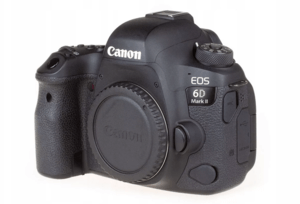
Frame sizes - 4:3, 3:2, 1:1, 16:9, continuous shooting from 150 shots for JPEG and 21 for RAW.
Matrix sensitivity 100 - 3200 ISO, extended indicators ISO51200, 6400, 12800, 50, 102400, 100, 25600, resolution 6240 × 4160.
The exposure metering system is divided into spot, evaluative and center-weighted, exposure compensation +/- 5 EV in 1/3 steps.
It is possible to manually adjust the aperture and exposure time, bracketing auto-processing.
Focusing is carried out on the face, manually, autofocus adjustment is possible.
Supports SDHC, SD, SDXC drives. Video recording takes place in two formats - MOV, MP4, up to 29 minutes. Functions - white balance adjustment, flash, HDR shooting, GPS, orientation sensor, dust protection. Interchangeable Canon EF mount lens.
The model does not lose its relevance in 2024-2025.
Technical properties:
- Type - mirror;
- Matrix: type / size / crop factor / MP - CMOS / 35.9 x 24 mm / 1 / 27.1;
- Timer / rate of shooting - 2.10s / 6.5fps;
- Shutter opening (X-Sync) - 30-1/4000s (1/180s);
- Autofocus / number of points - phase / 63 (45 cross);
- Frame parameter - JPEG (2 levels of compression), RAW;
- Battery - own, for 1200 photos;
- Video resolution, frequency - 50-60 fps at 1280? 720; 50-60 fps at 1920x1080;
- Dimensions / weight - 144x111x75 mm / 765 g.
pros
- Focusing;
- time-lapse;
- Electronic video stabilization;
- Ergonomics;
- Autonomous work;
- Protective characteristics.
Minuses
- One memory card slot;
- Autofocus points close to center.
The Best Interchangeable Lens Mirrorless Cameras for Beginning Photographers
Panasonic Lumix DMC-G7 Kit
Electronic viewfinder camera equipped with a tiltable LCD monitor. Shooting 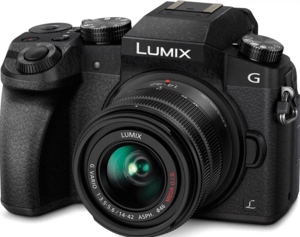
The number of pixels of the matrix is 4592 x 3448, the sensitivity is within 100-3200 ISO with advanced settings ISO6400, 12800, 100, 25600.
Exposure in auto processing is possible with aperture or shutter priority, exposure compensation +/- 5 EV in 1/3 steps.
Measurements of three types: multi-zone, center-weighted and spot, there is a manual setting of shutter speed and aperture, bracketing.
Focus is determined by the face or manual adjustment. Type of memory cards supported - SDHC, SD, SDXC. Video recording in MP4 and AVCHD formats up to 29 minutes.
Interchangeable lenses with Micro 4/3 mount, 3D and HDR shooting, 4x digital zoom, white balance adjustment, built-in flash, remote control are used.
Technical properties:
- Type - mirrorless;
- Matrix: type / size / crop factor / MP - Live MOS / 17.3 x 13.0 mm / 2 / 16.84;
- Timer / rate of shooting - 2.10s / 8fps;
- Shutter opening (X-Sync) - 120-1 / 16000s (1 / 160s);
- Autofocus - contrast;
- Frame parameter - JPEG (compressed level 2), RAW, TIFF;
- Battery - own, for 360 photos, 1200 mAh;
- Video resolution, frequency - 25-30 fps at 1280? 720; 50-60 fps at 1920x1080;
- Dimensions / weight - 125x86x77 mm / 360 g.
pros
- Functionality;
- Manual settings;
- Ergonomics;
- Quality.
Minuses
- Inaccurate charge indicator;
- Sound on video.
Olympus Pen E-PL8 Kit
The device is equipped with a touch-sensitive rotary LCD screen used as 
Continuous shooting allows you to take 20 frames for RAW in 4:3 format.
200-3200 ISO sensor with adjustable ISO6400, 12800, 25600 and 4608 x 3456 resolution.
Exposure metering systems - multi-zone, center-weighted and spot, there is bracketing, auto-processing, exposure compensation, and manual adjustment of exposure time and aperture. Focus on the face and manually corrected with backlight.
Support for SDHC, SD, SDXC drives, video recording in two formats AVI and MOV.
3D and HDR shooting is possible, sensor shift optical image stabilization, white balance adjustment and built-in flash. Interchangeable lens - Micro 4/3 mount.
Technical properties:
- Type - mirrorless;
- Matrix: type / size / crop factor / MP - LiveMOS / 17.3 × 13 mm / 2 / 17.2;
- Timer / shooting rate - 2.12.1-30s / 8fps;
- Shutter opening (X-Sync) - 60-1/4000s (1/250s);
- Autofocus / number of points - hybrid / 81 (9 cross);
- Frame parameter - JPEG, RAW;
- Battery - own, for 350 photos, 1210 mAh;
- Video resolution, frequency - 25-30 fps at 1280? 720; 25-30 fps at 1920x1080;
- Dimensions / weight - 115x67x38 mm / 357 g.
pros
- JPG quality;
- Stabilizer;
- Number of functions and settings;
- Battery operation.
Minuses
- Default menu;
- Heavy weight and uncomfortable ergonomics.
Canon EOS M100 Kit
A device with a rotary LCD touch screen that performs the functions of a viewfinder. 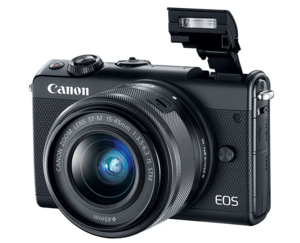
The number of pixels in the matrix is 6000 × 4000, ISO 100-3200, advanced settings ISO6400, 12800, 100, 25600.
Exposure metering - center-weighted, evaluative and spot, exposure compensation +/- 3 EV in 1/3 steps.
Manual aperture and hold time adjustment, automatic exposure processing.
Focusing manual or on the face with highlighting. Storage types SDHC, SD, SDXC, interfaces Wi-Fi, USB, Bluetooth, NFC.
29 minutes video recording in MP4 format.
The ability to shoot HDR, adjust the white balance, remote control, change optics. E-TTL II flash up to 5 m with red-eye reduction.
Technical properties:
- Type - mirrorless;
- Matrix: type / size / crop factor / MP - CMOS / 22.3 × 14.9 mm / 1.5 / 25.8;
- Timer / shooting rate - 2.10s / 6.1fps;
- Shutter opening (X-Sync) - 30-1/4000s (1/200s);
- Autofocus / number of points - phase / 49;
- Frame parameter - JPEG (compressed level 2), RAW;
- Battery - own, for 295 photos;
- Video resolution, frequency - 50-60 fps at 1280? 720; 50-60 fps at 1920x1080;
- Dimensions / weight - 108x67x35 mm / 302 g.
pros
- Compactness;
- The quality of shooting at night;
- Wireless technologies.
Minuses
- Limited functionality;
- Number and price of lenses.
The best mirrorless professional cameras
Sony Alpha ILCE-6400 Kit
The unit is equipped with an electronic viewfinder with a 100% field of view, LCD touch screen 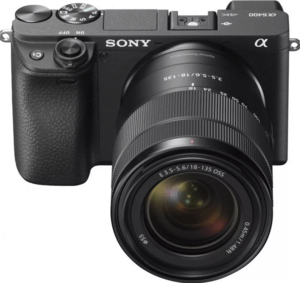
The maximum number of continuous shots for JPEG - 116, for RAW - 46, frame formats 3:2, 1:1, 16:9.
Matrix sensitivity 100-32000 ISO, extended ISO51200, 6400, 12800, 102400, 100, 25600, resolution 6000×4000. Auto exposure processing with aperture or shutter priority, manual exposure compensation, exposure compensation, bracketing.
Autofocus is adjustable, manual adjustment is also possible on the face.
Memory Card Support - SDHC, microSDXC, SD, Memory Stick/Duo/PRO-HG Duo/Pro Duo, microSD, SDXC, microSDHC.
Record video with sound but no commentary in AVCHD format. There is protection against moisture and dust, HDR shooting, control from a computer or remotely, 8x digital zoom, a USB connector allows you to charge the battery.
The white balance is set automatically, manually or according to the list, the flash is built-in, it is possible to change the optics Sony E mount.
This model has proven itself well in 2024-2025.
Technical properties:
- Type - mirrorless;
- Matrix: type / size / crop factor / MP - CMOS / 23.5 x 15.6 mm / 1.5 / 25;
- Timer / shooting rate - 2,3,5,10s / 11fps;
- Shutter opening - 30-1 / 4000s;
- Autofocus / number of points - hybrid / 425;
- Frame parameter - JPEG, RAW;
- Battery - own, for 410 photos;
- Video resolution, frequency - 120 frames / s at 1920 × 1080; 25/30 fps at 3840×2160;
- Dimensions / weight - 120x67x50 mm / 403 g.
pros
- No overheating;
- CPU;
- Quality;
- Ergonomics;
- Silent mode.
Minuses
- Battery life;
- No stabilizer.
Sony Alpha ILCE-7M3 Body
The device is equipped with an electronic viewfinder with a 100% field of view, LCD display for 3? 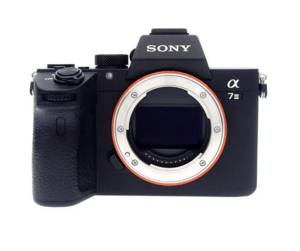
Continuous shooting is designed for 163 frames for JPEG and 89 for RAW, picture format 3:2, 16:9.
Matrix resolution 6000×4000, light sensitivity 100-3200 ISO, advanced features ISO51200, 6400, 12800, 50, 102400, 204800, 100, 25600.
There is a multi-zone, center-weighted and spot metering system, bracketing and auto-processing are possible.
Exposure compensation +/- 5 EV in 1/3 steps, manual calibration of exposure time and aperture.
Supports SDXC, SDHC, SD, Memory Stick/Duo/PRO-HG Duo/Pro Duo, AVCHD and MP4 video recording.
Optical image stabilization function with matrix shift, built-in flash, white balance adjustment, HDR shooting, interchangeable optics.
Technical properties:
- Type - mirrorless;
- Matrix: type / size / crop factor / MP - EXR CMOS / 35.6 x 23.8 mm / 1 / 25.3;
- Timer / shooting rate - 2.5.10s / 10fps;
- Shutter opening (X-Sync) - 30-1 / 8000s (1 / 250s);
- Autofocus - hybrid;
- Frame parameter - JPEG (compressed level 3), RAW;
- Battery - own, for 710 photos;
- Video resolution, frame rate -120 fps at 1920×1080; 25-30 fps at 3840?2160;
- Dimensions / weight - 127x96x74 mm / 650 g.
pros
- Focusing;
- Viewfinder;
- shooting speed;
- Functionality;
- Ergonomics.
Minuses
- Screen;
- Menu;
- Case quality.
Sony Alpha ILCE-7M3 Kit
The camera is equipped with an electronic viewfinder, a touch-sensitive swivel LCD screen with 
The number of burst frames for JPEG 163 and 89 for RAW, photo size 3:2, 16:9.
Matrix sensitivity 100-3200 ISO with a choice of ISO51200, 6400, 12800, 50, 102400, 204800, 100, 25600, the maximum number of pixels is 6000 × 4000.
Exposure adjustment is carried out through bracketing, metering systems, exposure compensation, auto processing, aperture and fixation time settings.
Focusing occurs on the face or in manual mode with backlight.
Supported media types - Memory Stick/Duo/PRO-HG Duo/Pro Duo, SDHC, SD, SDXC, AVCHD and MP4 video recording formats.
Image stabilization takes place by an optical method with a matrix shift, a built-in flash suppresses the red-eye effect. White balance adjustment (auto and manual), HDR shooting, remote control, interchangeable lenses.
Technical properties:
- Type - mirrorless;
- Matrix: type / size / crop factor / MP - EXR CMOS / 35.6 x 23.8 mm / 1 / 25.3;
- Timer / shooting rate - 2.5.10s / 10fps;
- Shutter opening (X-Sync) - 30-1 / 8000s (1 / 250s);
- Autofocus - hybrid;
- Frame parameter - JPEG (compressed level 3), RAW;
- Battery - own, for 710 photos;
- Video resolution, frequency - 120 frames / s at 1920 × 1080; 25-30 fps at 3840?2160;
- Dimensions / weight - 127x96x74 mm / 650 g.
pros
- Autofocus;
- Autonomous work;
- Image quality;
- Video recording.
Minuses
- Work speed;
- Faded screen.
The best digital (compact) cameras
Sony Cyber-shot DSC-RX100
The LCD screen of the device with a diagonal of 3? used instead of viewfinder. Focus distance from 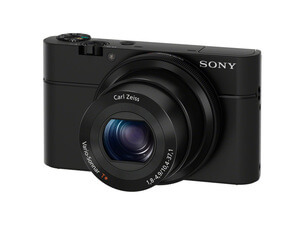
Possibility of macro shooting, frame sizes 4:3, 3:2, 1:1, 16:9. Matrix resolution 5472×3648, ISO 80-3200 with ISO6400, 12800, 25600 capabilities.
Exposure with multi-zone, center-weighted and spot metering, exposure compensation, auto-processing and manual adjustment of aperture and exposure time are possible.
There is face focusing, manual adjustment, the minimum distance is 0.05 m.
Equipped with slot for SDHC, SD, SDXC, Memory Stick/Duo/PRO-HG Duo/Pro Duo drives.
Video recording in two formats AVCHD and MP4 with sound. White balance adjustment function, optical image stabilization using a moving element in the lens. Built-in flash with a range of up to 6.3 m. Additionally, there is a stereo microphone.
Technical properties:
- Type - compact;
- Matrix: type / size / crop factor / MP - CMOS / 13.2 x 8.8 mm / 2.7 / 20.9;
- Timer / rate of shooting - 2.10s / 10fps;
- Optical zoom / digital - 3.60x / 2x;
- Aperture - F1.8-F4.9;
- Autofocus - contrast;
- Frame parameter - JPEG, RAW;
- Battery - own, for 330 photos;
- Video resolution, frequency - 50-60 frames / s at 1920 × 1080;
- Dimensions / weight - 102x58x36 mm / 213 g.
pros
- Matrix;
- Low noise;
- Compactness;
- shooting modes.
Minuses
- Ergonomics;
- Expensive accessories.
Canon PowerShot G9 X Mark II
Camera without viewfinder with LCD touch screen. Focal 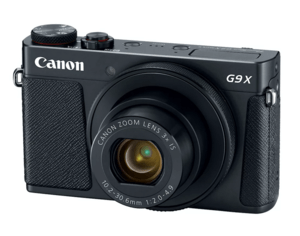
Number of continuous shots 38 for JPEG, 21 for RAW, image formats 4:3, 3:2, 1:1, 16:9, work in Time-lapse and macro photography. The number of pixels of the matrix is 5472 x 3648, ISO 125-3200 with advanced ISO6400, 12800.
Exposure with manual aperture and shutter speed, automatic processing, bracketing, exposure compensation and metering systems.
For focusing, the minimum distance is 0.05 m, it is possible to focus manually or by face.
Uses SDHC, SD, SDXC memory cards, USB slot with charging support. The video is recorded in MP4 format with a duration of 29 minutes.
The moving part in the lens stabilizes the image, the flash is built-in, the white balance is set automatically, manually or from the list.
Technical properties:
- Type - compact;
- Matrix: type/size/crop factor/MP – BSI CMOS/13.2×8.8 mm/2.7/20.9;
- Timer / shooting rate - 2.10s / 8.2fps;
- Shutter opening (X-Sync) - 30-1/2000s (1/2000s);
- Optical zoom / digital - 3x / 4x;
- Aperture - F2-F4.9;
- Autofocus - contrast;
- Frame parameter - JPEG (compressed level 2), RAW;
- Battery - own, for 235 photos;
- Video resolution, frequency - 25-30 fps at 1280? 720; 50-60 fps at 1920? 1080;
- Dimensions / weight - 98x58x31 mm / 206 g.
pros
- Matrix;
- Optical stabilizer;
- Compactness;
- Number of settings.
Minuses
- Battery capacity;
- Impossible to shoot while charging.
Fujifilm XF10
The device uses an LCD touch screen instead of a viewfinder. Focal length 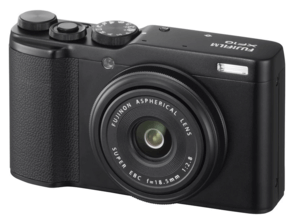
Matrix with a resolution of 6000 × 4000, ISO 200-3200, deep - ISO51200, 6400, 12800, 100, 25600.
Shooting is possible in Time-lapse mode, for JPEG format the maximum number of frames in burst photos is 13 pcs.
Exposure meters: multi-zone, center-weighted and spot; bracketing, exposure compensation, auto-processing and manual exposure time and aperture settings are used.
Minimum focusing distance - 0.1 m, focusing is carried out on the face or manually.
Memory cards are supported type SDHC, SD, SDXC up to 256 GB, dual RAW + JPEG recording is possible, the USB slot supports charging. The video is recorded in MP4 format for 29 minutes.
Built-in flash with a range of up to 5.3 m, white balance adjustment.
Technical properties:
- Type - compact;
- Matrix: type / size / crop factor / MP - CMOS / 23.5 x 15.7 mm / 1.5 / 24.2;
- Shooting rate - 6fps;
- Shutter opening - 30-1 / 16000s;
- Aperture - F2.8;
- Autofocus / number of points - hybrid / 91;
- Frame parameter - JPEG (compressed level 2), RAW;
- Battery - own, for 330 photos;
- Video resolution, frequency - 25-30 fps at 1280? 720; 50-60 fps at 1920x1080; 4K 3840?2160 - 15 fps;
- Dimensions / weight - 113x64x41 mm / 279 g.
pros
- Ergonomics;
- The size;
- Image quality;
- Control.
Minuses
- Autofocus;
- Battery life.
Customer Reviews
Useful video
From the video you will learn how to choose a camera:



